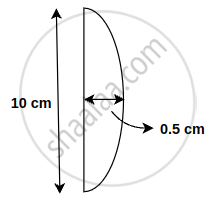Advertisements
Advertisements
प्रश्न
A double convex lens of + 5 D is made of glass of refractive index 1.55 with both faces of equal radii of curvature. Find the value of its radius of curvature.
उत्तर
From lens maker formula, we have
\[P = (\mu - 1)\left( \frac{1}{R_1} - \frac{1}{R_2} \right)\]
\[\text { where} \]
\[ P =\text { Power of lens } = + 5 D\]
\[\mu = \text { Refractive index of the lens } = 1 . 55\]
\[ R_1 =\text { Radius of curvature of first face } \left( + ve \right)\]
\[ R_2 = \text { Radius of curvature of second face } \left( - ve \right)\]
\[\text {Given }: \]
\[ R_1 = R_2 = R\]
\[ \Rightarrow P = (\mu - 1)\left( \frac{1}{R_1} - \frac{1}{R_2} \right)\]
\[ \Rightarrow 5 = (1 . 55 - 1)\left( \frac{1}{R} - \frac{1}{- R} \right)\]
\[ \Rightarrow 5 = (1 . 55 - 1)\left( \frac{2}{R} \right)\]
\[ \Rightarrow 5 = 0 . 55\left( \frac{2}{R} \right)\]
\[ \Rightarrow R = \frac{0 . 55 \times 2}{5}\]
\[ \Rightarrow R = 0 . 22 m\]
APPEARS IN
संबंधित प्रश्न
An object of size 3.0 cm is placed 14 cm in front of a concave lens of focal length 21 cm. Describe the image produced by the lens. What happens if the object is moved further away from the lens?
A screen is placed 90 cm from an object. The image of the object on the screen is formed by a convex lens at two different locations separated by 20 cm. Determine the focal length of the lens.
Figure shows an equiconvex lens (of refractive index 1.50) in contact with a liquid layer on top of a plane mirror. A small needle with its tip on the principal axis is moved along the axis until its inverted image is found at the position of the needle. The distance of the needle from the lens is measured to be 45.0 cm. The liquid is removed and the experiment is repeated. The new distance is measured to be 30.0 cm. What is the refractive index of the liquid?

An equiconvex lens of focal length 'f' is cut into two identical plane convex lenses. How will the power of each part be related to the focal length of the original lens ?
Two converging lenses of unequal focal lengths can be used to reduce the aperture of a parallel beam of light without loosing the energy of the light. This increase the intensity. Describe how the converging lenses should be placed to do this.
A pin of length 2.0 cm lies along the principal axis of a converging lens, the centre being at a distance of 11 cm from the lens. The focal length of the lens is 6 cm. Find the size of the image.
Answer the following question.
An optical instrument uses a lens of 100 D for the objective lens and 50 D for its eyepiece. When the tube length is kept at 20 cm, the final image is formed at infinity.
(a) Identify the optical instrument.
(b) Calculate the magnification produced by the instrument.
An object approaches a convergent lens from the left of the lens with a uniform speed 5 m/s and stops at the focus. The image ______.
Will the focal length of a lens for red light be more, same or less than that for blue light?
A plano convex lens has diameter of 10 cm and its thickness at the centre is 0.5 cm. Speed of light in the lens is 2 × 108 ms-1. What is the focal length of the lens?

